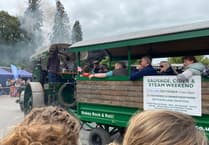ENVIRONMENTAL gardeners have welcomed a plan to install so-called living roofs on Tavistock bus shelters.
The town council, in partnership with Launceston-based Fernbank Advertising, is providing shelters with mini-gardens on the roofs as an environmental measure to support other green moves.
The roofs will be provided as part of the council’s ‘ongoing sustainability and environment commitment’. They are described by the council as a ‘living roof shelter’ with ready-made shallow planters designed to aid the capture of carbon emissions from traffic and homes and encourage wildlife. The shelters will be lit by solar power and use a dusk-till-dawn sensor.
Green roofs comprise a layer of vegetation planted over a waterproofing system on a flat or slightly sloped roof. They are also known as vegetative or eco roofs.
Ali Sedgwick, chair of Tavistock Community Gardening, said: This is an absolutely brilliant idea. It will extend the provision for pollinators that Tavistock Town Council is steadily putting in place throughout the town. It’s planting another under-used area, adding to the existing wildlife corridors that are being created.’
The most wide spread type of green roofs are so-called cassettes, these are made on a modular basis, already planted with the succulent sedum plant which is well suited for shallow planting on roofs. Sedum, as a succulent similar to a cactus, is also tolerant of harsh conditions like exposure to strong drying winds and dry conditions and other extreme weather. They are planted in common cactus soil which comprises sand and perlite, made from volcanic glass to aid drainage and save weight.
Excess rain travels through the growing medium, passes through a filter layer and flows to the roof drains. The water is either taken up by the plants or evaporates. Another benefit is helping to alleviate flooding in towns by reducing the water run-off entering drains.
Green roofs are more expensive than traditional roofs, weigh more and require extra maintenance.
Among the areas in Tavistock created to attract pollinators such as bees and butterflies are the ‘green burial ground’ in Plymouth Road Cemetery, where a meadow has been established and judged to be ‘outstanding’ twice by Royal Horticultural Society judges in the SW Britain in Bloom contests. The town council mows a single path, allowing for environmentally friendly scything of the grass, instead of mowing. The resulting hay is raked and removed to allow wildflowers to thrive undisturbed and populated by flying insects.
Other sections of managed green corridors are in the Meadows park, Dolvin Road Cemetery (with 12 species of native bats) Benson’s Meadows, Market Road river bank, newly-planted hedges in Bannawell Park and in the Plantations pocket park, next to Abbey Bridge.





Comments
This article has no comments yet. Be the first to leave a comment.